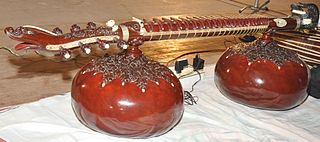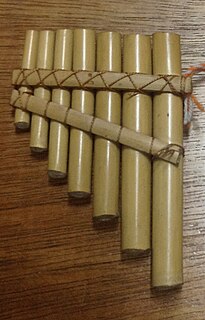
String instruments, stringed instruments, or chordophones are musical instruments that produce sound from vibrating strings when a performer plays or sounds the strings in some manner.

Zither is a class of stringed instruments. Historically, the name has been applied to any instrument of the psaltery family, or to an instrument consisting of many strings stretched across a thin, flat body. This article describes the latter variety.

The Appalachian dulcimer is a fretted string instrument of the lute family, typically with three or four strings, originally played in the Appalachian region of the United States. The body extends the length of the fingerboard, and its fretting is generally diatonic.

The geomungo or hyeongeum is a traditional Korean plucked zither with both bridges and frets. Geomungo is a representative stringed instrument made in Goguryeo before the 5th century. Scholars believe that the name refers to Goguryeo and translates to "Goguryeo zither" or that it refers to the colour and translates to "black crane zither".

Ektara is a one-stringed musical instrument used in the traditional music of South Asia, and used in modern-day music of Bangladesh, India, and Pakistan.

The yueqin, also called a moon lute or moon guitar, is a traditional Chinese string instrument. It is a lute with a round, hollow soundboard, a short fretted neck, and usually four strings. It is an important instrument in the Peking opera orchestra, often taking the role of main melodic instrument in lieu of the bowed string section.

The Rudra veena —also called Bīn in North India—is a large plucked string instrument used in Hindustani classical music, especially dhrupad. It is one of the major types of veena played in Indian classical music, notable for its deep bass resonance.

Traditional Korean musical instruments comprise a wide range of string, wind, and percussion instruments. Many traditional Korean musical instruments derive from Chinese musical instruments.
The kutiyapi, or kudyapi, is a Philippine two-stringed, fretted boat-lute. It is four to six feet long with nine frets made of hardened beeswax. The instrument is carved out of solid soft wood such as that from the jackfruit tree.
Traditional Vietnamese musical instruments are the musical instruments used in the traditional and classical musics of Vietnam. They comprise a wide range of string, wind, and percussion instruments, used by both the Viet majority as well as the nation's ethnic minorities.
Traditional Thai musical instruments are the musical instruments used in the traditional and classical music of Thailand. They comprise a wide range of wind, string, and percussion instruments played by both the Thai majority as well as the nation's ethnic minorities.

Traditional Cambodian musical instruments are the musical instruments used in the traditional and classical music of Cambodia. They comprise a wide range of wind, string, and percussion instruments, used by both the Khmer majority as well as the nation's ethnic minorities.

The épinette des Vosges is a traditional plucked-string instrument of the zither family, whose use was confined to two areas in the Vosges mountains of France approximately 50 km apart: around Val-d'Ajol and around Gérardmer.

The sasando, also called sasandu from Sandu or Sanu, is a tube zither, a harp-like traditional music string instrument native to Rote Island of East Nusa Tenggara, Indonesia.
The takumbo is a parallel-stringed tube zither made from bamboo, and is found in the Philippines. It is made from a heavy bamboo tube about 40 cm long, with both ends closed with a node. Two strands of strings, about 5 cm apart, are partially etched out from the body of the bamboo. Small wooden bridges are inserted beneath the strings at both ends. At the center of the bamboo tube, below the strings, a small hole is bored. The small hole is covered with a bamboo plate clipped to the strings.

The Diwas is a native bamboo wind instrument from the Philippines that is a variation of the well-known pan flute or panpipes. It is made of bamboo, with one end closed with bamboo nodes. It does not have finger holes like other popular aerophones, such as flutes. The Diwas compensates by grouping pipes of graduated lengths together. The player shifts from one pipe to another to produce sounds with varying pitches. In Kalinga, these individual pipes are known as saggeypo, which is why the Diwas is sometimes called saggeypo. The number of attached saggeypos can range from five to eight.

The veena, also spelled vina, comprises various chordophone instruments from the Indian subcontinent. Ancient musical instruments evolved into many variations, such as lutes, zithers and arched harps. The many regional designs have different names such as the Rudra veena, the Saraswati veena, the Vichitra veena and others.

The tube zither is a stringed musical instrument in which a tube functions both as an instrument's neck and its soundbox. As the neck, it holds strings taut and allows them to vibrate. As a soundbox or it modifies the sound and transfers it to the open air. The instruments are among the oldest of chordophones, being "a very early stage" in the development of chordophones, and predate some of the oldest chordophones, such as the Chinese Se, zithers built on a tube split in half. Most tube zithers are made of bamboo, played today in Madagascar, India, Southeast Asia and Taiwan. Tube zithers made from other materials have been found in Europe and the United States, made from materials such as cornstalks and cactus.

The eka-tantrī vīṇā was a medieval tube-zither veena in India, with a single string and one or more gourd resonators. The instrument became prominent in Indian music in about the 10th century C.E. as instruments of court music. Alongside the alapini vina and kinnari vina it replaced the harp-style veenas and lute-style veenas in sculpture. It was possibly a forerunner of the rudra vina. It shares its name with the modern single-string drone lute, the ektara.

The ālāpiṇī vīṇā was a medieval stick-zither veena in India, with a single string and a gourd resonator. Later forms added more strings. The instruments became prominent in Indian music after 500 C.E. as instruments of court music. Alongside the eka-tantri vina and kinnari vina it replaced the harp-style veenas and lute-style veenas. The instruments were used in Southeast Asia, both mainland and island nations, and were recorded in sculpture and relief sculpture.



















